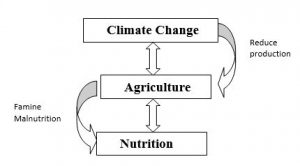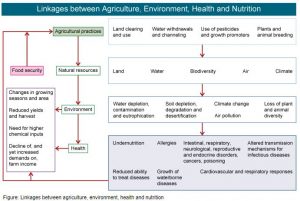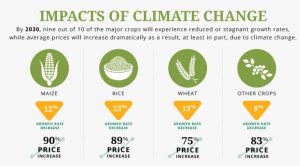
- Before talking about the Linkage between climate change, agriculture and nutrition lets us know what Climate change, agriculture and nutrition means.
- Climate change refers to a change in the state of the climate that can be identified (e.g. using statistical tests) by changes in the mean and/or the variability of its properties and that persists for an extended period, typically decades or longer. (IPCC). For more details, please go to: https://publichealthnotes.com/climate-change-developing-countries/
- Agriculture is the process of cultivating, planting for growing eatable crops and conducting livestock farming in order to get food, wool and other materials.
- “Nutrition is the intake of food, considered in relation to the body’s dietary needs.” (WHO)
Relationship between Climate change, Agriculture and nutrition

- Climate change, agriculture and nutrition are closely interrelated to each other.
- Climate change brings changes in average temperature, change in atmospheric carbon-dioxide, rainfall pattern and natural calamities such as drought, floods etc.
- Due to increase in greenhouse gases found in the atmosphere, more heat waves coming from the sun is trapped by it, as a result, average temperature of earth is rising resulting in lowering of water table, rising sea level, heat stress, flood, drought etc.
- Agriculture is intrinsically liked to environment; any changes in environment are going to affect agricultural production directly or indirectly.
- As air is becoming warmer, more moisture is being evaporated from land, water bodies and also from plant, which causes damage or death of plant. It is found that about 40% population of the world depends on agriculture as the main source of income. If severe drought strikes on areas that are agriculture dependent then it may have devastating impact on farmers, community people and other animals depending on it. When agriculture production reduces then ultimately the price of the food increases and will be less affordable to people which in turn will result in hunger, malnutrition among people.
- Changes in severity and frequency of droughts and flood pose a greater risk to agriculture and food security. Drought lessens the production of crops while flood washes away all the crops that have been produced.
- Also, for greater food production for growing population, more land is required, trees are cut down and space is created for agricultural land. Low trees means low area for carbon dioxide absorption and more carbon dioxide goes to the atmosphere increasing the greenhouse gases leading to climate change
- Increase in temperature also result in increase in pest number which will affect crops and may cause disease in animals. Also, high temperature reduces animal’s fertility and amount of milk production.

- Fish farming is also highly temperature dependent, change in water temperature and pH level of water will greatly affect its habitat and reduce its numbers.
- As agricultural production is challenged due to global climate change, more pesticides is added to crops and later when human consume these crops high in pesticide may result in poisoning in humans.
- The relationship between Climate change and agriculture goes both ways. Not only the Climate Change affects the Agriculture but also agriculture contributes to green house effect.
- According to EPA, agriculture contributes, 14% of green house gas emission. Fertilizers, pesticides, tractors etc used in agriculture production produces greenhouse gases such as carbon dioxide, methane, nitrous oxide and other green house gases that contribute to global climate change.
- Agriculture is also related to nutrition. World Bank identifies five pathway through with agriculture is linked to human nutrition:
- Subsistence-oriented production for the household’s own consumption
- Income-oriented production for sale in markets
- Reduction in real food prices associated with increased agricultural production
- Empowerment of women as agents instrumental to household food security and health outcomes
- Indirect relationship between increasing agricultural productivity and nutrition outcomes through the agriculture sector’s contribution to national income and macroeconomic growth
- Studies have found that rising carbon dioxide decreases the nutritional content of many food crops such as rice, wheat, soya bean etc as a result individual consuming that food product may not receive adequate amount of nutrition which can cause undernutrition in people.
- When food production is decreased, the price of the product will increase and become less affordable to all people and as a result of low availability and access to food product people may suffer from different nutritional deficiency disorders.
- Studies have found that by year 2030, growth rate of 9 out of 10 crops will significantly reduce or may remain constant where as the price rate will increase as a result of climate change.

- So, in this way, climate change, agriculture and nutrition are interlinked.
References and for more information:
https://www.climaterealityproject.org/blog/facts-about-climate-change-and-drought
https://en.wikipedia.org/wiki/Climate_change_and_agriculture
http://climate.ncsu.edu/edu/k12/ClimateChange-Ag
http://www.who.int/topics/nutrition/en/
https://nutrirejournal.biomedcentral.com/articles/10.1186/s41110-016-0028-4
https://depts.washington.edu/ceeh/downloads/FF_Pesticides.pdf
https://en.wikipedia.org/wiki/Climate_change_and_agriculture#Pest_Insects_and_Climate_Change
https://www.ifad.org/newsroom/press_release/tags/p23/y2014/2791592
https://ehp.niehs.nih.gov/1104424/
http://www.bbc.com/news/science-environment-15202668
http://blogs.nicholas.duke.edu/exploring-green/agricultures-contribution-to-climate-change/
http://blogs.worldbank.org/health/nutrition-and-agriculture-bridging-gap
http://www.nytimes.com/health/guides/nutrition/pesticides/overview.html
https://nutritionfacts.org/topics/pesticides/
https://ccafs.cgiar.org/blog/flipping-issue-agriculture-contributes-climate-change#.WfhlzFtL_IU
http://www.planetexperts.com/how-much-does-agriculture-contribute-to-global-warming/
http://www.wri.org/blog/2014/05/everything-you-need-know-about-agricultural-emissions
https://www.treehugger.com/green-food/6-ways-agriculture-impacts-global-warming.html
http://siteresources.worldbank.org/INTARD/825826-1111134598204/21608903/January2008Final.pdf
http://ageconsearch.umn.edu/bitstream/16152/1/nb020006.pdf
Author of this article: Ms. Rojina Tandukar. Ms. Tandukar is pursuing her degree in Public Health from a reputed University.